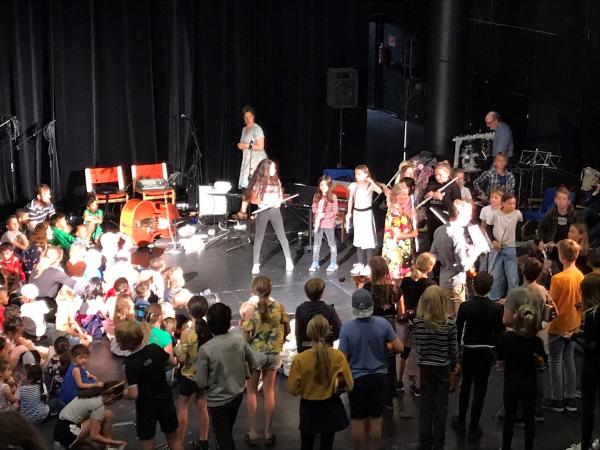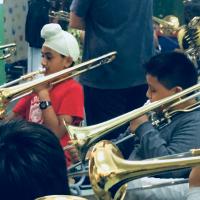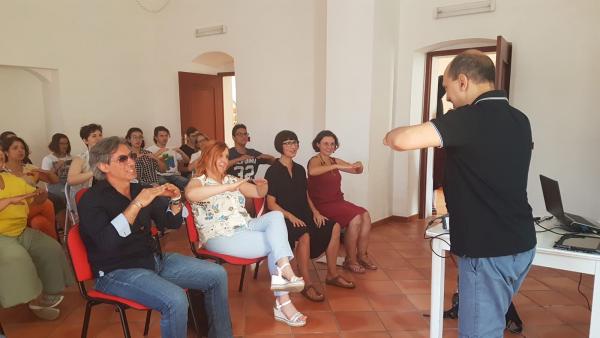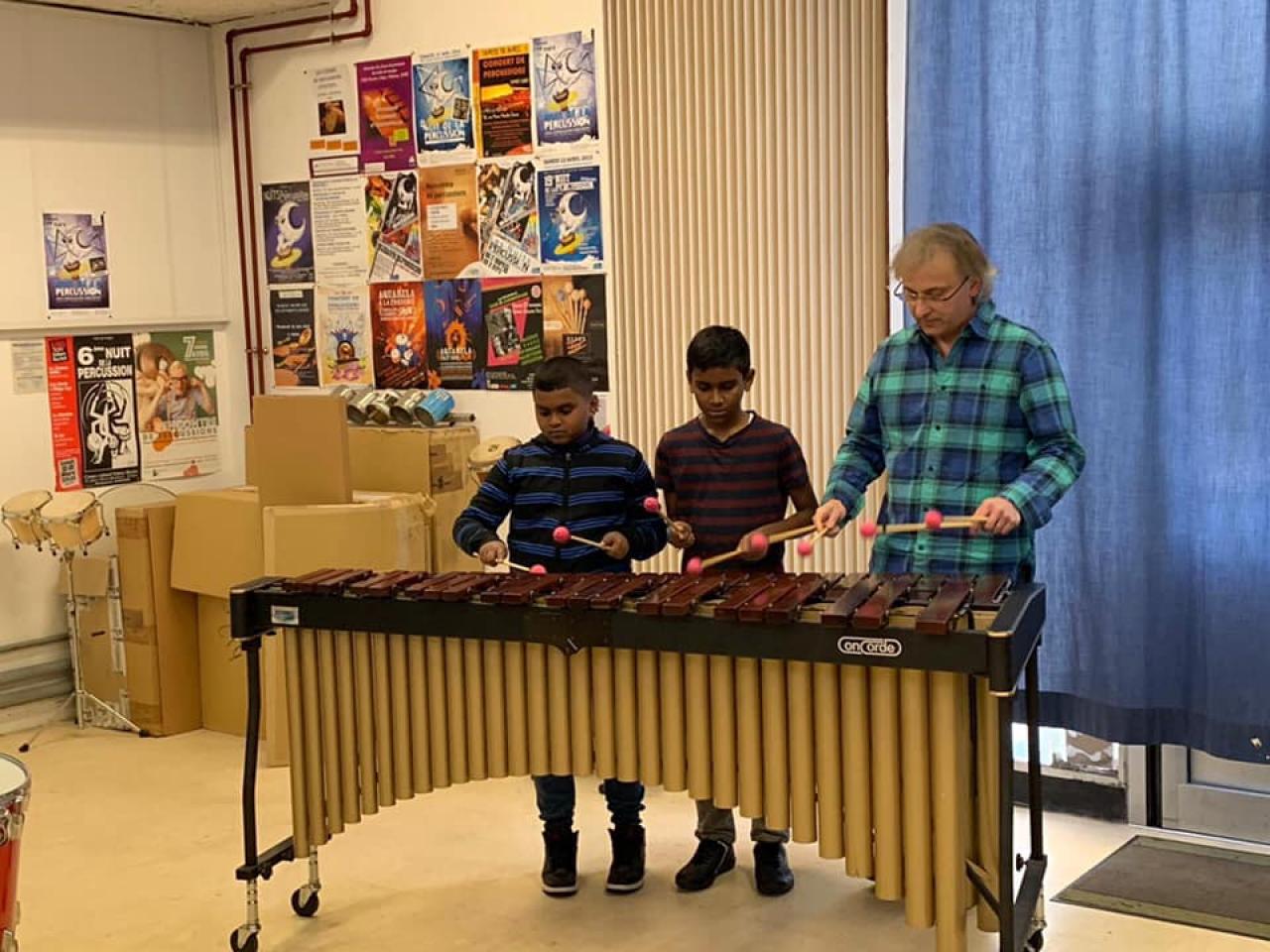Sandra Rainero, network Expert for URBACT ONSTAGE Transfer Network, shares the experiences of l’Hospitalet de Llobregat (ES), Grigny (FR), Adelfia (IT) and Aarhus (DK).
Nothing touched the heart of the people of l’Hospitalet de Llobregat (ES) more than the Opening Ceremony (the Toc d’Inici) of the Spring Festival and the music of the Banda Provençana. During the festival, the band showcased the traditions and popular Catalan culture of the city. Today, its French horn player is 18-year old Wang Wei,* a Chinese national who arrived in L’Hospitalet at the age of 9, enrolled in the neighbourhood school and joined the Tandem programs of the Municipal Music School and Arts Centre (EMMCA).
Surely music schools are the most exclusive education system there is?
Conservatories and schools are attended mainly by those who have either a good enough social and cultural background to afford it, or budding talents that get to the spotlight thanks to heavy discipline, solfege, vocalising and exhausting practice. However, one performing arts schools has gone a long way to undermine such stereotypes opening its doors to today’s diverse and complex society: the EMMCA in L’Hospitalet (ES), now sharing its Good Practice within the URBACT ONSTAGE Transfer Network.
Urbanity and education: a multifaceted and complex relationship
Typically, cities have a subsidiary role in a formal education system, so when they govern education programmes – regardless of their level, groups or topic – they make a strong political statement. It's even more so when we add in cultural education. As American sociologist Christian Smith would argue, cultural systems are the result of human capacities to shape the meanings and structures of social existence together.
This is why the cities of the URBACT ONSTAGE Transfer Network use music and performing arts education to equip citizens with the so-called “cultural and artistic capability”. They view access to culture as a fundamental right for citizens.
Living on the margins but playing for its heart
People of L’Hospitalet (pop. 250,000 c.) and Grigny (pop. 28,500 c.) are those living at the margins, on the fringes of the largest metropolitan areas in Spain and France, namely Barcelona and Paris. Until not so long ago they were both little suburban towns. Life in Gellerup (pop. 340,000 c) seems a world apart from the thriving city of Aarhus, yet it was named the European Capital of Culture in 2017.
As migrants make up for about one-third of the residents (90% in Gellerup), over time these three municipalities have structured public music schools where the egalitarian approach has replaced the elitist one. While teaching music, these schools offer opportunities and different ways to empower those who often fall between the cracks of our society, because of their cultural, ethnic, national background or other forms of diversities and vulnerabilities.

Conservatory Director Edgar Solmi recalls that it was the Department of Grand Paris South that came to the Grigny conservatoire a few years back, right after the violence in the social housing district of La Grande Borne (Big Border) and asked for musical help to appease the inflammatory social unrest. The Conservatory therefore plays an important part in the municipality’s strategy with Grigny being named City of Peace to change its story, and to offer its citizens better opportunities.
The city of Aarhus has been investing an important amount of financial resources for the regeneration of Gellerup, building public spaces and moving a large Department of the City Administration to this part of the city. The focus of the activities of the Musikskole in this district are part of a wider policy and city strategy.
The EMMCA’s activities started in 2005, but the school moved to its own headquarters about ten years later as part of the urban regeneration project for the Gornal district, known as a difficult neighbourhood home to a large Roma community, initially shunned by L’Hospitalet residents. The educational objective of this urban policy came before the actual school building and it took time and incessant networking with the social fabric of the city to get its value recognised.
Musical atonement for the school’s ‘original sin’
The Greek etymon of school, skholḗ means “place of rest”, a respite from the body’s toils and a place to exercise the mind. Over the last millennium, this artificial separation between the body and the mind has persisted, making it hard for students who do not comply (because of their diversity, background, learning or behavioural issues) to succeed and meet educational standards. So, human expressions and arts that entail the simultaneous use of body and mind, such as music or performing arts, remain the Cinderella subjects of “regular” schools - or exclusive to specialised (and often even more exclusive) education.

The wager that the EMMCA took up when it started its Tandem programme in public primary schools meant including music, dance or theatre into the curriculum, but also to teaching them at the same level and valuing them as much as other subjects.
“If math and English can be taught in a group-class, why not music?” The educational objective does not refer to achieving a standard artistic performance level (although this happens quite often anyway) but rather the well-being and the feeling of safety in the group that fosters the ability to learn.
In Aarhus, the experience of the Musikskole has also revealed its limitations. After years of “incursions” in regular classes by music teachers, musical education remained a world apart from ‘real life’ for its students because regular teachers were unable to give continuity to music classes.
As financial resources dwindle, the focus has recently shifted to providing other teachers with skills to continue the musical activities. The new approach is to combine music-teaching with social skill building, to embed the aesthetic didactics (songs, activities and methods) into the school’s daily routines. The project of online animations with traditional Danish songs also goes in this direction.
For many years now, musician Andrea Gargiulo of MusicaInGioco has been working with children with disabilities and behavioural issues in Adelfia and other municipalities in the Puglia Region. He has codified practice and multidisciplinary techniques into a methodological approach called "reticular didactics" that the Italian Ministry of Education has recognised.
“I worked with Suleyman,* a deaf boy who was also unable to speak because in his country, Albania, he had spent a lot of time in the orphanage without receiving adequate care” Gargiulo recalls, “but though he could not speak, he could sing! He managed to develop his own self-regulation and managed to be even in tune, and to improvise jazz on the piano, resting his hand on the sound box.”
Another strength of the inclusive approach to music education is that they draw and adapt from non-formal, experiential and inductive education approaches. As the experience of EMMCA and the Adelfia tell us, these methods are more flexible and inclusive because they drift away from the mistake-and-performance-evaluation paradigm. They aim at personal and social empowerment, rather than achievement, therefore they have a profound social and therapeutic value.
A slow but inevitable recognition
EMMCA’s music lessons have made of Wang Wei an important element of the city’s musical life, and all along they have helped him go through education, learn the local language and become an active citizen, applauded by the local community in the parades.
When Suleyman’s adoptive mother saw him singing and playing for the first time, she broke into tears of joy. She was convinced that her son could never be a musician, and instead she saw him doing it with incredible simplicity and talent.

Neuroscience and evidence-based research carried out on L’Hospitalet and Adelfia’s cases indicate that music and dance have positive effects on the brain, activate neural connections and logical abilities, improving social, behavioural and mathematical skills. However, the introduction of music and performing arts in the general education system by local actors (like the Tandem programs of the EMMCA and Music’n’play) have not happened overnight and are not always welcome by the system. Their actual implementation has shown how difficult it remains to change the formal education system.
One of the enduring issues related to performing arts education relates to its costs for the local administration, especially when a rights-based, democratic approach to culture is promoted.
The Catalan Government, in the case of EMMCA, the Department of Grand Paris South for Grigny and the Puglia Region for Music’n’Play all support these initiatives, with the help of private donors. Territorial and vertical alignment of integrated policy and good practice remain therefore paramount for their sustainability. The dialogue we see happening during the ONSTAGE Transfer Network about cultural, education and social policy is encouraging for these schools to set their plans for social change in motion.
*fictional name of a real person


